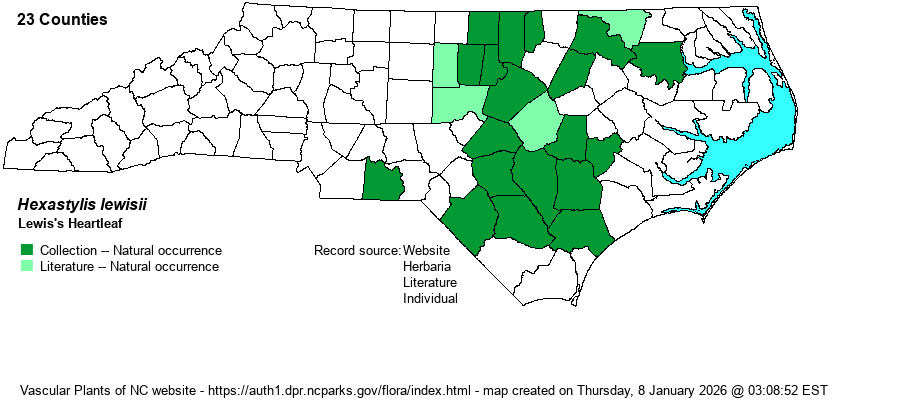| Author | (Fernald) Blomquist & Oosting | |
| Distribution | Present across a wide north-south band through the eastern Piedmont and western and southern Coastal Plain, though absent in the Sandhills proper. The population in Anson County occurs at Pee Dee NWR in a unique Wet Piedmont Flatwoods community, along with many Coastal Plain species.
This has a small range from south-central VA though east-central NC, apparently not quite reaching SC.
| |
| Abundance | Uncommon to infrequent, though can be locally numerous in a few areas. Though formerly tracked as a rare species by the NCNHP, it has been downgraded to just Watch List status. Likely, if it were not for its very restricted global range, it would be removed from the Watch List. | |
| Habitat | This is a Hexastylis species unlike most others, as it favors level or only gently sloping ground, never in hilly or rocky situations like most others. It favors the shade of drier and more "upland" portions of floodplain forests (not where wet), but it also is found in mesic to dry, but always acidic, upland forests, usually under hardwoods or mixed hardwoods and pines. Normally, it is found growing with one to several species of low-growing blueberries (Vaccinium spp.) or huckleberries (Gaylussacia spp.). It can be found along or near the edges of pocosins and bay forests in the southern Coastal Plain. As it is clonal, it is always found in colonies; a few of them number in the thousands of leaves and cover several acres of ground. |
| Phenology | Blooms infrequently, and usually only where the flower is raised and exposed to some sunlight, such as at the base of a tree. It blooms from May into June, later than nearly all others in the genus, and fruits shortly after flowering. However, a plant with fully developed flower on 31 March 2024 suggests that this species blooms earlier than we think. | |
| Identification | This is an odd Hexastylis, quite different from the other variegated leaved species. It is strongly clonal owing to having horizontal rhizomes that send up a single leaf at a node, rather than a distinct clump of several leaves in a single plant. Thus, when you find one or two leaves, a bit of exploring usually uncovers dozens to hundreds of leaves scattered across the forest floor, at times in a dense patch but more often simply "here and there" for many yards in several directions. The leaf is evergreen, somewhat triangular rather than rounded like other evergreen species, with a rounded tip and with somewhat straight sides, and a cordate base. The leaf is about 3 inches long and nearly as wide, thick and glossy dark green, with white to pale green along the veins. The species flowers very poorly, and often you will not find a single flower in a population. When you get lucky and see one, it is fairly large (usually just one flower at a node), at least 1 inch long and nearly as wide, light brown, urn-shaped to cylindrical, with three triangular lobes that are strongly covered in white hairs there and inside the calyx tube. This species and H. arifolia are the only NC Hexastylis species, other than the strange Rose's Heartleaf (Hexastylis rosei), that can be identified solely by the leaves. In parts of the range, such as in forests near Falls Lake north of Raleigh, it is not hard to find, but the difficulty is to find a flower of the species. | |
| Taxonomic Comments | None
| |
| Other Common Name(s) | None | |
| State Rank | S3 | |
| Global Rank | G3 | |
| State Status | W1 | |
| US Status | | |
| USACE-agcp | | |
| USACE-emp | | |

